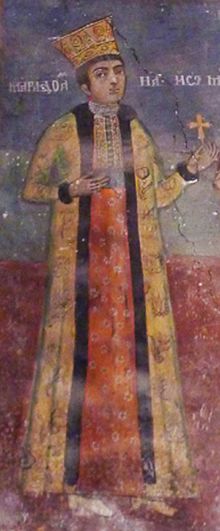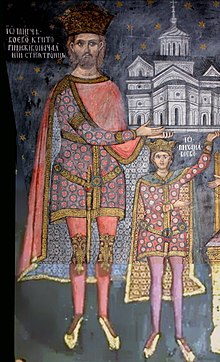
Basarab I, also known as Basarab the Founder, was a voivode and later the first independent ruler of Wallachia who lived in the first half of the 14th century. Many details of his life are uncertain. Although his name is of Turkic origin, 14th-century sources unanimously state that he was a Vlach (Romanian). According to two popular theories, Basarab either came into power between 1304 and 1324 by dethroning or peacefully succeeding the legendary founder of Wallachia, Radu Negru, or in 1310 by succeeding his father, Thocomerius.
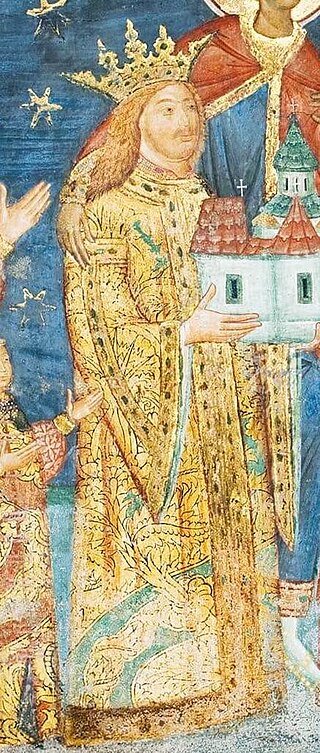
Stephen III, commonly known as Stephen the Great ; died on 2 July 1504), was Voivode of Moldavia from 1457 to 1504. He was the son of and co-ruler with Bogdan II, who was murdered in 1451 in a conspiracy organized by his brother and Stephen's uncle Peter III Aaron, who took the throne. Stephen fled to Hungary, and later to Wallachia; with the support of Vlad III Țepeș, Voivode of Wallachia, he returned to Moldavia, forcing Aaron to seek refuge in Poland in the summer of 1457. Teoctist I, Metropolitan of Moldavia, anointed Stephen prince. He attacked Poland and prevented Casimir IV Jagiellon, King of Poland, from supporting Peter Aaron, but eventually acknowledged Casimir's suzerainty in 1459.

Mircea the Elder was the Voivode of Wallachia from 1386 until his death in 1418. He was the son of Radu I of Wallachia and brother of Dan I of Wallachia, after whose death he inherited the throne.

The Order of the Dragon was a monarchical chivalric order only for selected higher aristocracy and monarchs, founded in 1408 by Sigismund of Luxembourg, who was then King of Hungary and Croatia and later became Holy Roman Emperor. It was fashioned after the military orders of the Crusades, requiring its initiates to defend the cross and fight the enemies of Christianity, particularly the Ottoman Empire.

Vlad II, also known as Vlad Dracul or Vlad the Dragon, was Voivode of Wallachia from 1436 to 1442, and again from 1443 to 1447. He is internationally known as the father of Vlad the Impaler, or Dracula. Born an illegitimate son of Mircea I of Wallachia, he spent his youth at the court of Sigismund of Luxembourg, who made him a member of the Order of the Dragon in 1431. Sigismund also recognized him as the lawful Voivode of Wallachia, allowing him to settle in nearby Transylvania. Vlad could not assert his claim during the life of his half-brother, Alexander I Aldea, who acknowledged the suzerainty of the Ottoman Sultan, Murad II.

Vlad III, commonly known as Vlad the Impaler or Vlad Dracula, was Voivode of Wallachia three times between 1448 and his death in 1476/77. He is often considered one of the most important rulers in Wallachian history and a national hero of Romania.
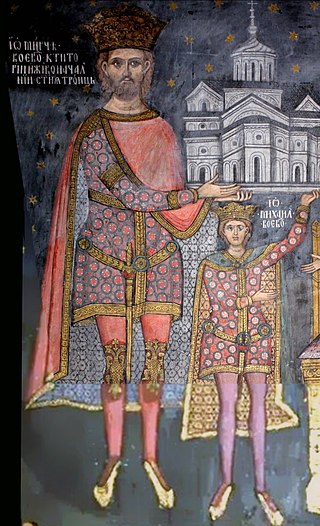
Michael I, was Voivode of Wallachia from 1415 to 1420. He was the only legitimate son of Mircea I of Wallachia, who made him his co-ruler. Styled as prince from 1415, Michael became sole ruler after his father died in early 1418. His support for a Hungarian campaign against the Ottoman Empire caused the Ottoman Sultan, Mehmed I, to invade Wallachia, forcing him to agree to pay tribute. After Michael failed to respect the treaty, the Ottomans gave assistance to his rival, Dan, who crossed into Wallachia in 1420. Dan and his Ottoman allies defeated the Wallachian army, and Michael was killed on the battlefield.

Dan II cel Viteaz was a voivode of the principality of Wallachia, ruling an extraordinary five times, and succeeded four times by Radu II Chelul, his rival for the throne. Of those five periods on the throne of Wallachia, four were within a period of only seven years.
Mircea II (1428–1447) was the Voivode, or prince, of Wallachia in 1442. He was the oldest son of Vlad II Dracul and brother of Vlad Țepeș and Radu the Handsome. He was the grandson of his namesake Mircea cel Bătrân.
Basarab IV cel Tânăr, also known as Țepeluș, son of Basarab II, and grandson of Dan II (1422-1431) was 4 times the voivode of the principality of Wallachia between 1474 and 1482: from Oct to Dec 1474, from Jan 1478 to June 1480, from Nov 1480 to before July 1481, and again from Aug 1481 to July 1482.

Vlad IV Călugărul was the Prince of Wallachia in 1481 and then from 1482 to 1495.

Michael the Brave, born as Mihai Pătrașcu, was the Prince of Wallachia, Prince of Moldavia (1600) and de facto ruler of Transylvania (1599–1600). He is considered one of Romania's greatest national heroes. Since the 19th century, Michael the Brave has been regarded by Romanian nationalists as a symbol of Romanian unity, as his reign marked the first time all principalities inhabited by Romanians were under the same ruler.
The House of Drăculești were one of two major rival lines of Wallachian voivodes of the House of Basarab, the other being the House of Dănești. These lines were in constant contest for the throne from the late fourteenth to the early sixteenth centuries. Descendants of the line of Drăculești would eventually come to dominate the principality, until its common rule with Transylvania and Moldavia by Mihai Viteazul in 1600.
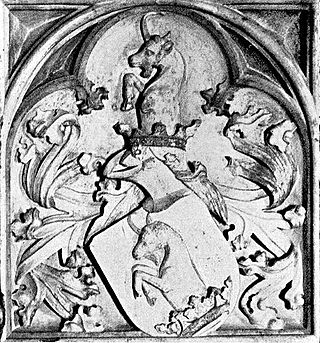
Justina Szilágyi de Horogszeg was a Hungarian noblewoman, who became the second wife of Vlad Dracula, Voivode of Wallachia. She was the daughter of Ladislaus or Osvát Szilágyi and thus a cousin of Matthias Corvinus, King of Hungary. Corvinus first gave her in marriage to Wenceslas Pongrác of Szentmiklós. Pongrác had inherited estates in Upper Hungary, but was forced to renounce them in exchange for landed property he and Justina jointly received in Transylvania following their marriage. After Pongrác died in 1474, the widowed Justina married Vlad, whom Corvinus acknowledged as the lawful voivode of Wallachia in 1475. Vlad seized Wallachia in late 1476, but soon died in battle. To strengthen her claim to her Transylvanian estates, she married Paul Suki, who was related to the former owners of those territories. After the death of Suki, in 1479, Justina was married to John Erdélyi of Somkerék, until her death in 1497.
The 1973 Romania rugby union tour of Argentina was a series of matches played between August and September 1973 by Romania national rugby union team in Argentina. The "Pumas" won both test matches against the European side.

Constantin Gane was a Romanian novelist, amateur historian, biographer and memoirist. Born into the boyar aristocracy of Western Moldavia, he worked as a lawyer in Bucharest, achieving literary notoriety with his recollections from the Second Balkan War and the Romanian front of World War I. By the 1930s, he was primarily a writer on historical and genealogical topics, famous for his contribution to women's history. An apologist for Romanian conservatism and Junimism, Gane also completed in 1936 a biography of Petre P. Carp. He was editor at Convorbiri Literare and a columnist for Cuvântul, also putting out his own literary newspaper, Sânziana.
Clara Dobokai was the second wife of Nicholas Alexander, Voivode of Wallachia.

Dan the Younger was a pretender to the throne of Wallachia from 1456 to 1460. He was the son of Dan II of Wallachia who died fighting for the throne in 1431. After Dan's brother, Vladislav II of Wallachia, was killed by their cousin, Vlad Dracula, in a duel in 1456, Dan settled in Brașov. Besides Dan, Vlad Dracula's half-brother, Vlad the Monk, and Dan's brother, Basarab Laiotă, laid claim to Wallachia against Dracula. Dan tried to seize Wallachia with the support of the burghers of the town, but he was defeated and captured in a battle near Rucăr. He was forced to dig his own grave before being beheaded.

Nicolae Pătrașcu, Petrașco, or Petrașcu, also styled Nicolae Vo(i)evod, was the titular Prince of Wallachia, an only son of Michael the Brave and Lady Stanca, and a putative grandson of Pătrașcu the Good. His early childhood coincided with Michael's quick rise through the ranks of boyardom, peaking in 1593, when Michael became Prince and Nicolae his heir apparent. As he began a quest to emancipate Wallachia from the Ottoman Empire, Michael used his son as a party to alliances with the Holy Roman Empire and the Principality of Transylvania, proposing him as either a hostage or a matrimonial guarantee. While entering the Long Turkish War on the Christian side, Michael also negotiated a settlement with the Ottomans, again offering Nicolae as a guarantee.
Ruxandra Basarab was a Romanian princess. She was the daughter of Neagoe Basarab and Milica of Serbia, and became princess consort of Wallachia by her marriage to Radu Paisie.
